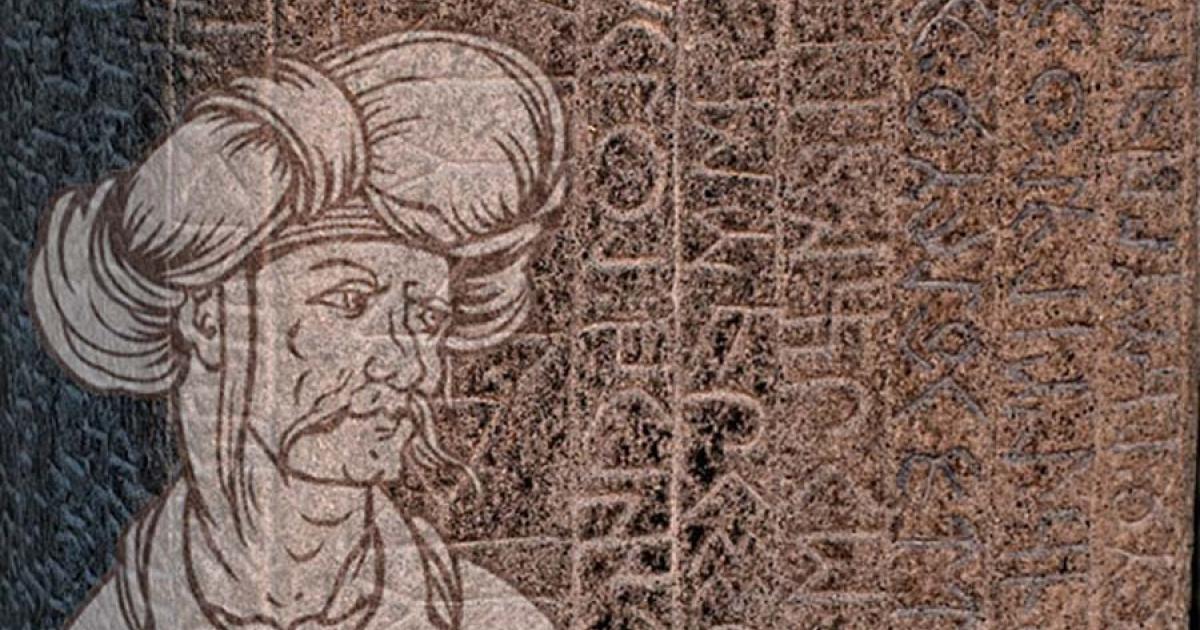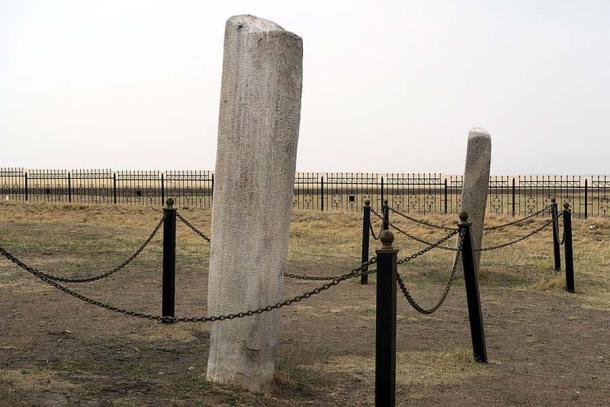
The Triumphs of Tonyukuk the Wise, Supreme Commander and Kingmaker
Today the steles of Tonyukuk the Wise are situated at an immensely popular and historical 1300-year-old memorial site. It is located northwest of Bayantsogt Mountain in Erdene Soum, Mongolia. Tonyukuk the Wise was an advisor for three successive Khans in the Turkic Khaganate and for this he has been described as a kingmaker by some historians. The memorial complex is also popularly known as the 'Place of Sacrifice'!
The memorial site has two steles with inscriptions, and along with that, there is an engraved stone platform. This engraved stone is named the kurgan stele, and is broken at the top. Besides that, this site also has other small standing stones, bricks, irrigation systems, and pottery.
Researchers have been studying the steles of Tonyukuk since 1897. There is a belief that the monuments were erected between 720 and 734 AD.
A joint project carried out by the Ministry of Education, Science, Culture, and TIKA, worked on restoring and protecting Turkic monuments located in Mongolia. In order to support this initiative, fences are now constructed around the memorial complex. The monuments are also now under Mongolian state protection.

Bilge Tonyukuk monuments in Mongolia. (Vezirtonyukuk/CC BY-SA 4.0)
This site has experienced the wrath of wind and sun damage, which has darkened some of the features and writing.
About Tonyukuk the Wise
Tonyukuk was said to be the owner of pure and deep ideas. He’s also called Bilgä (Bilge) Tuňuquq, with ‘Bilge’ meaning “a master or wise person.” He was born into the Ashide Tribe, near the Tuul River in the year 646. He was born into a family of noblemen and powerful aristocrats. Tonyukuk took his last breath in the year 732, at the age of 86. But he accumulated a lot of achievements and recognition before the year 732.
- The Eerie Balbal Statues of the Eurasian Steppe
- The Khazars: A Forgotten Medieval Empire that Ruled the Northern Caucasus
Chinese sources state that Tonyukuk's real name was Yuanzhen and that he was well aware of Chinese traditions. Along with that, he was also aware of all the loopholes and gaps in the Chinese walls and borders. When he was in charge of supervising all the clans that surrendered in the Chanyu Military governorship he was dismissed and jailed by Changshih, a military governor.
Under Qapyan's reign, he served as an advisor for Kutulug Khan and Qapaghan Khan, following which he continued to work for Bilge Khan until his death. During Qapaghan Khan's reign, he was sent with a marriage proposal to China, where Wu Zetian accepted the proposal. With the acceptance of this proposal, Wu Yanxiu was released upon the order of the Khagan. But in the long run, Emperor Zhongzhong changed the political climate, and the marriage was canceled.

Shoroon Bumbagar tomb mural, Göktürk, 7th century AD, Mongolia. (Public Domain) Tonyukuk the Wise was a supreme commander and adviser of four successive Göktürk khagans.
Words of Tonyukuk the Wise
There are 62 rows of Tonyukuk inscriptions on 8 different sides of the two monuments at the Bayn Tsokto site in Mongolia. To be precise, the first monument is 217 cm tall (7.12 ft.) and consists of the first 37 rows of the inscription about Tonyukuk the Wise. The second monument is 243 cm tall (7.97 ft.), and has rows 38 to 62 of the inscription.
The inscriptions were engraved when Tonyukuk the Wise was still alive, as evidenced by writing that says, “But should a people, ruled by a Khagan in any land whatever, have only worthless men [at its head] what misfortune would it not be for it. For the Turkish Bilge Khagan’s people, I have had this written. I the wise Tonyukuk.”
With this inscription, it is confirmed that Tonyukuk was alive when he had these inscriptions written.
Researchers have studied all of the inscriptions and say that they convey a lot about Tonyukuk's viewpoint of the social situation at that time.
The 1st stele has inscriptions discussing:
- The revolt of the Turks in 681 against Tang China on the West side.
- The war with the Oghuz Turks on the South side.
- The successful capture of 23 cities, along with the plan of counterattack upon possible neighbor alliances, on the East side.
- The Defeat of Yenisei Kirghiz and a campaign to the Turgesh on the North side.

Tonyukuk Stele 1. (atalarmirasi.org)
The 2nd stele mentions:
- The Battle of Boichu against the Turgesh and the Onoq territory annexation of Turkestan on the West side.
- The annexation of 7 campaigns of Ilterish Qaghan for Khitan people and Temir Kapig on the South side.
- Tonyukuk praising himself on the East side.
- The Epilogue, after all the victories, is mentioned on the inscription of the North side.
Explanation of the Tonyukuk Inscriptions
Here is a detailed explanation of all the inscriptions of Tonyukuk the Wise on the first stele. These inscriptions intend to give a precise description of social interactions and war in Tonyukuk’s time.
1st Stele, West Side
In this inscription, Tonyukuk addressed himself as "I, the wise Tonyukuk." He wrote that when he was born he belonged to the Chinese empire because all the Turkish people were under China back then. He wondered if he might live to see Turkish people getting a Khan of their own.
Soon the Turkish people did break away and found their own Khan. But they soon deposed their Khan and surrendered back to China. As a punishment for this submission, heaven caused the Turkish people to die. The Turkish people ultimately fell to ruin, languished, and perished.

Copy of a tracing of the western face of the Tonyukuk inscription. (Public Domain)
1st Stele, South Side
Tonyukuk is addressing a whole community in this inscription. He wrote, "We lived here and nourished ourselves." Their mouths were filled with food, but their foes were all around them, like birds of prey. It was their unavoidable situation!
A few Turkish people rose up and demonstrated their bravery, and their Khan is said to have stood out at this time. The counselor was wise and the Chinese said that if this Khan and his counselor survived, they would slay them all. So, the Chinese decided to attack them from the South and the Kitays from the East. They intended to ensure that no Turkish people should prosper.
They had 2000 men, and heaven helped them to cut up the enemies and throw them into the river, so they could possess the Otukan Land. Now, the Turkish Khagan and Turkish people headed to the Otukan land, and Tonyukuk the Wise decided to settle in the Otukan land too. All the people who were wandering around West, North, East, and South joined them at the Otukan Land.

Göktürk petroglyphs from Mongolia (6th to 8th cent. AD). (Public Domain)
1st Stele, East Side
The 2000 men were divided into 2 armies. These two armies reached Shantung plain and the sea but ultimately found destruction. 23 towns were laid to waste, and the camp was made in Usin Bundatu. The Chinese Emperor, Khagan of Ten Arrows, and the Kirghizes were their enemies.
All of the khagans brought the council together and asked them to meet in Altun, the mountain forest. And, thus, they took the counsel and discussed upon moving against the khagan of Eastern Turks. They thought unless they made a move, Tonyukuk the Wise would unfailingly slay them.
All the foes were uniting and planning to destroy Tonyukuk together. The khagans agreed and it made Tonyukuk restless. He then decided to first march against the Kirghizes. The only Kogman route was shut down due to snow, for which Tonyukuk decided that it was not the right decision to go that way. He then found a man who guided him with a route from Ani. He could take the route but with only one horse at a time. He then decided that things were possible if he went that way.
1st Stele, North Side
Tonyukuk prepared the army for the march! He ordered the army to get on the backs of their hoses. While he gave the order, he paved the way through the snow. In the complex route, he asked the army to walk while making their horses walk behind them. Soon, on foot, the army crossed Ibar. And now the difficulty was to climb down! They continued to walk on the mountainside barriers for ten long days. The ride continued, and when they rode across the river, they decided to tie the horses to trees and march ahead.
- The Tapestry of Early Turkic Myth is Woven with Tales of Wolves, Horses and a Great Tree of Life
- Spectacular photographs shed light on the ancient nomadic lifestyle of Mongolia
After riding for day and night, they fell on the Kirghizes in their asleep. The Khan and his army gathered to fight the Kirghizes and won. Their Khan was killed, and the people submitted to Khagan and gave up. After that, they went back again through the side of Kogan mountain forest to turn their back on the Kirghizes.
Tonyukuk had a lot of willpower, and he gave the army permission to march through the Altun mountain forest. There was no road and they had to cross the River Irtish. They marched throughout the night and reached Bolchu in the morning hours.
Preserving and Protecting the Memorial
This is a brief narration of Tonyukuk's memorial and the inscriptions that he left behind of his significant war and social interactions.

Tonyukuk memorial complex. (atalarmirasi.org)
Researchers are still working to pull more historical insight from these inscriptions. To aid in this pursuit, the Tonyukuk steles are being conserved and under state protection.
Top Image: Representation of an old Turkic Warrior. (Pix Sector) Turkic inscriptions of the 8th century on a stele dedicated to Tonyukuk the Wise in Mongolia. (CeeGee/CC BY-SA 4.0)
By Bipin Dimri
References
Denison Ross, E. and Vilhelm Thomsen. 1930. ‘The Tonyukuk Inscription: "Being a Translation of Professor Vilhelm Thomsen's Final Danish Rendering."’ Bulletin of the School of Oriental Studies, University of London. Available at https://www.jstor.org/stable/607296?seq=1
Munkhzul, A. 2021. ‘1300-year-old Stele of Tonyukuk the Wise.’ Montsame. Available at https://montsame.mn/en/read/260121
Yergaliyeva, A. 2019. ‘Tonyukuk inscriptions to celebrate 1,300th anniversary next year.’ The Astana Times. Available at https://astanatimes.com/2019/05/tonyukuk-inscriptions-to-celebrate-1300th-anniversary-next-year/
















Comments
Pretty cool. Best story here in a while.